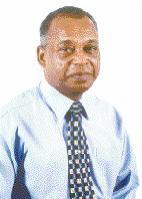
Tony Becca THE NEW ICC Cricket Committee held a two-day meeting in Dubai on Wednesday and Thursday and at the end, there were some recommendations that could see some interesting changes in the game of cricket - particularly so in the one-day version.
The committee, chaired by India's Sunil Gavaskar and including the likes of Mark Taylor of Australia, Michael Holding of the West Indies, Ranjan Madugalle of Sri Lanka, Ian Bishop of the West Indies, Duleep Mendis of Sri Lanka, Mahela Jayawardene of Sri Lanka and umpire Simon Taufel, decided to recommend a number of things to the ICC for its consideration.
One recommendation is that as far as ball-tampering is concerned, any action or actions t the condition of the ball which are not specifically permitted under Law 42.3 may be regarded as unfair.
Another is that before they become a part of the game, player appeals to the television umpire must be tried in as many countries as possible so that further evidence of its effectiveness or otherwise can be obtained.
Still another is that a task force be set up to look at whether or not it is appropriate for umpires to stand in Tests and other ICC events where their home country is involved.
One-day power plays
Apart from the surprise recommendation of a task force to look at whether umpires should stand in matches involving their home country, the really interesting recommendations surrounds one-day cricket.
The committee, for example, has recommended that the use of power-plays should continue but that there should be three and not two players outside of the 30-yard circle during the second and third power-plays and that unlike now when he has no say whatsoever, the captain of the batting side should be able to choose when to take one of the power-plays.
The committee also recom-mended a mandatory change of the ball after 35 overs and, following on what happens in twenty/20 cricket, that a free hit be introduced for the delivery that follows a front-foot no-ball.
Although some of the recom-mendations, including the one that further evidence of its effectiveness is needed re the player appeal to the television umpire and the one about the umpire standing in matches where his home country is involved, seem another case of cricket turning a blind eye on the facts of life, some of them seem fair and definitely would make the game a better game.
In the case of the power-play, cricket is a game between the bat and the ball - the batting side and the fielding side, and it does not seem right, for example, that there are three power-plays and all of them are taken when the captain of the fielding side wants to do so.
Fair play suggests that the batting side deserves at least one call.
In a one-day game, the ball, the white ball, often times gets black long before the 50 overs are bowled. Whenever it gets black it is difficult to see and instead of leaving it to the umpires to determine whether it is good enough or not for play, instead of leaving it to someone's discretion, the better way to go, the way that will leave no doubt in anyone's mind, must be to change it after a specific number of overs. Most times, a white ball 35 overs old is ready to be changed.
Dealing with no ball
The recommendation I am not too sure about is the one dealing with the front-foot no-ball and the free-hit.
According to the rule as it is now, one penalty run is awarded to the batting side whena no-ball is bowled. The batsman cannot be out except if he handles the ball, he hits the ball twice, he obstructs the field or he is run out.
In other words, a batsman can attempt to do anything with the ball because he cannot be bowled, he cannot be leg before wicket, he cannot be caught and he cannot be stumped. On top of that, the bowler has to bowl an additional ball in the over.
The reason why I am not sure about the free hit, however, is this these days the bowler often gets away with a no-ball for the simple reason that the front-foot rule, as against the back foot rule of years ago, makes it more difficult for the batsman to hear the umpire's call in time to take advantage of it, by giving away a run and by being forced to bowl an extra delivery, the bowler will be penalised twice for one mistake.
Looking at the list of members of the committee, batsmen far outnumber bowlers and that may well be why, like the one dealing with the power-plays, this particular recommendation favours the batsman.

